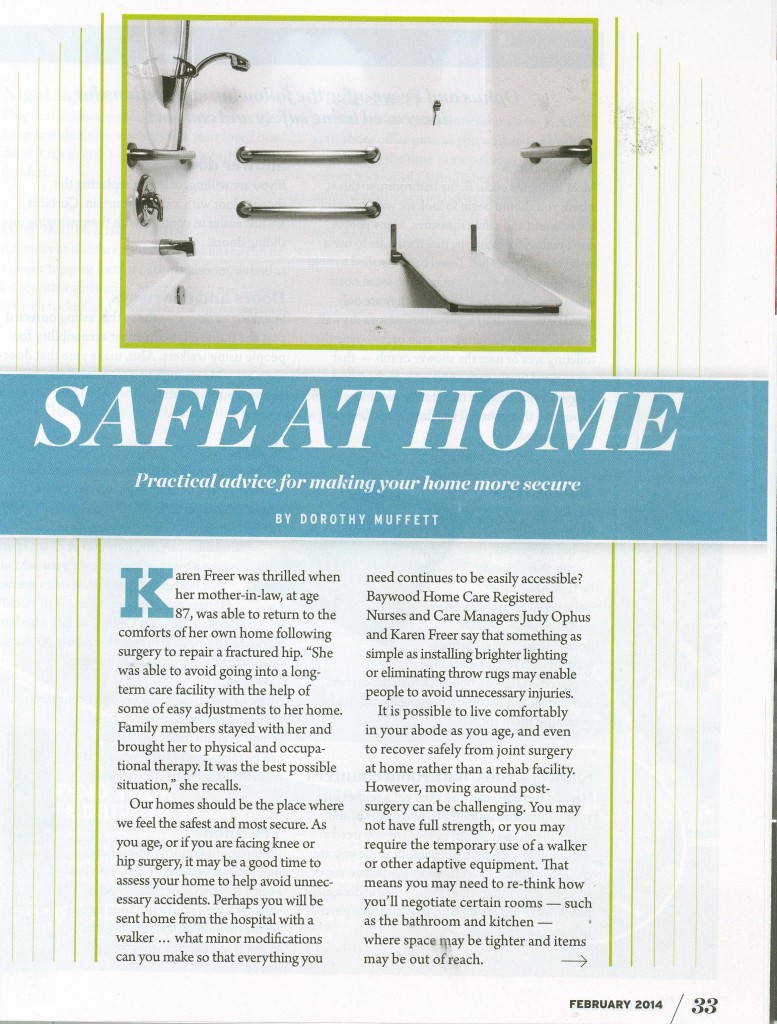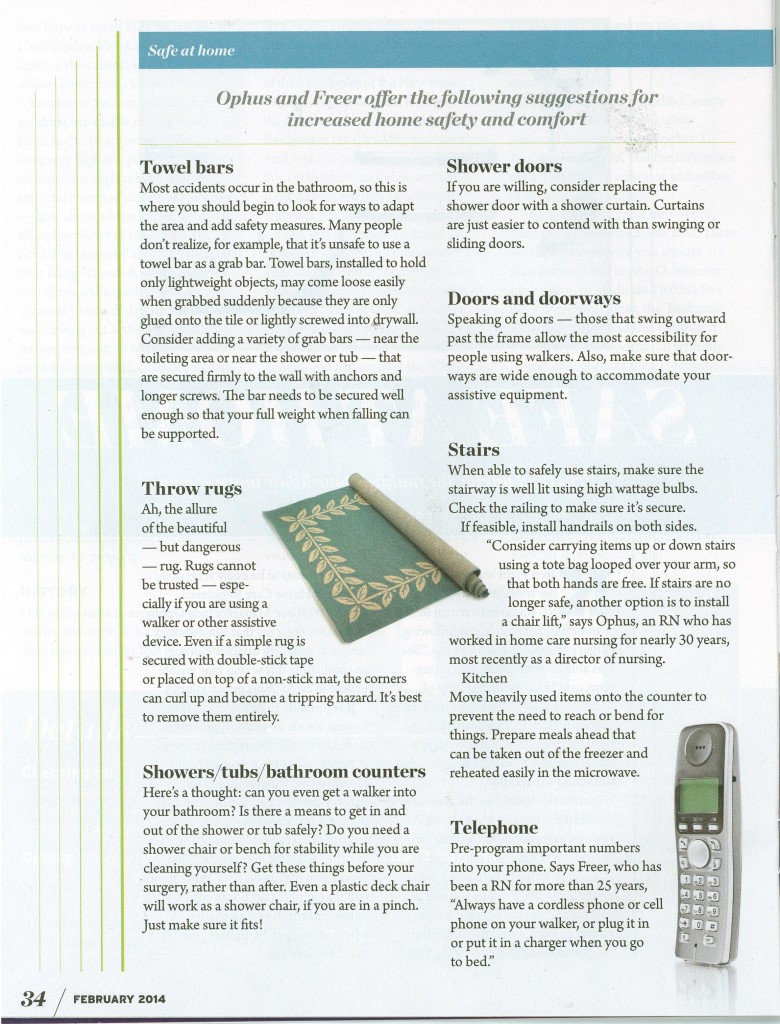Safe At Home – Making Your Home More Secure
Practical advice for making your home more secure
By Dorothy Muffett
Karen Freer was thrilled when her mother-in-law, at age 87, was able to return to the comforts of her own home following surgery to repair a fractured hip. “She was able to avoid going into a long-term care facility with the help of some easy adjustments to her home. Family members stayed with her and brought her to physical and occupational therapy. It was the best possible situation,” she recalls.
Our homes should be the place where we feel the safest and most secure. As you age, or if you are facing knee or hip surgery, it may be a good time to assess your home to help avoid unnecessary accidents. Perhaps you will be sent home from the hospital with a walker … what minor modifications can you make so that everything you need continues to be easily accessible? Baywood Home Care Registered Nurses and Care Managers Judy Ophus and Karen Freer say that something as simple as installing brighter lighting or eliminating throw rugs may enable people to avoid unnecessary injuries.
It is possible to live comfortably in your abode as you age, and even to recover safely from joint surgery at home rather than a rehab facility. However, moving around post-surgery can be challenging. You may not have full strength, or you may require the temporary use of a walker or other adaptive equipment. That means you may need to re-think how you’ll negotiate certain rooms – such as bathroom and kitchen – where space may be tighter and items may be out of reach.
Ophus and Freer offer the following suggestions for increased home safety and comfort.
Towel Bars
Most accidents occur in the bathroom, so this is where you should begin to look for ways to adapt the area and add safety measures. Many people don’t realize, for example, that it’s unsafe to use a towel bar as a grab bar. Towel bars, installed to hold only lightweight objects may come loose easily when grabbed suddenly because they are only glued onto the tile or lightly screwed into drywall. Consider adding a variety of grab bars – near the toileting area or near the shower or tub – that are secured firmly to the wall with anchors and longer screws. The bar needs to be secured well enough so that your full weight when falling can be supported.
Throw rugs
Ah, the allure of the beautiful — but dangerous — rug. Rugs cannot be trusted – especially if you are using a walker or other assistive device. Even if a simple rug is secured with double-stick tape or placed on top of a non-stick mat, the corners can curl up and become a tripping hazard. It’s best to remove them entirely.
Showers/tubs/bathroom counters
Here’s a thought: can you even get a walker into your bathroom? Is there a means to get in and out of the shower or tub safely? Do you need a shower chair or bench for stability while you are cleaning yourself? Get these things before your surgery, rather than after. Even a plastic deck chair will work as a shower chair, if you are in a pinch. Just make sure it fits!
Shower doors
If you are willing, consider replacing the shower door with a shower curtain. Curtains are just easier to contend with than swinging or sliding doors.
Doors and doorways
Speaking of doors — those that swing outward past the frame allow the most accessibility for people using walkers. Also, make sure that doorways are wide enough to accommodate your assistive equipment.
Stairs
When able to safely use stairs, make sure the stairway is well lit using high wattage bulbs. Check the railing to make sure it’s secure. If feasible, install handrails on both sides. “Consider carrying items up or down stairs using a tote bag looped over your arm, so that both hands are free. If stairs are no longer safe, another option is to install a chair lift,” says Ophus, an RN who has worked in a home care nursing for nearly 30 years, most recently as a director of nursing.
Telephone
Pre-program important numbers into your phone. Says Freer, who has been a RN for more than 25 years, “Always have a cordless phone or cell phone on your walker, or plug it in or put it in a charger when you go to bed.”
Night lights
Plug in motion-sensor lights or make sure a table lamp is within easy reach so that your loved ones doesn’t try to make their way to the bathroom in the dark.
Kitchen
Move heavily used items onto the counter to prevent the need to reach or bend for things. Prepare meals ahead that can be taken out of the freezer and reheated easily in the microwave.
Bed skirts and linens
As pretty as they are, bed skirts and linens can be a major tripping hazard in the bedroom, as bad as a rug with a curly edge. Make sure all bed linens are well tucked and nothing is resting on the floor.
Floor clutter
Are you one of those Minnesotans who kicks your shoes off as soon as you walk in the door? Well, now is the time to stop that nonsense. Take it from 85-year-old John Robert, who recently suffered a fall when he cut a corner short and tripped over shoes he’d left to dry in the hallway near his front door.
Ophus and Freer say that many of these tips come from combined decades of experience, as well as from the clients themselves. “We develop close relationships with our clients and their families,” says Ophus. “Home safety is just one way that we can make people’s lives better every day.”
Additional tips for making your home more secure can be found here.








